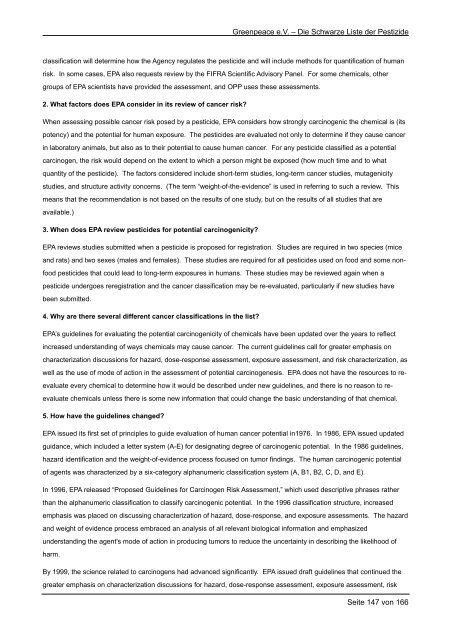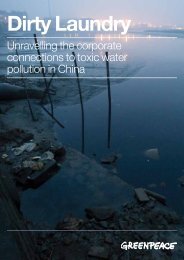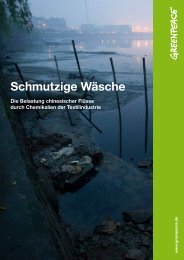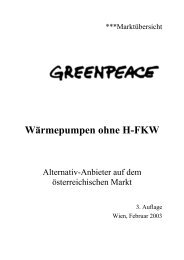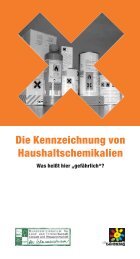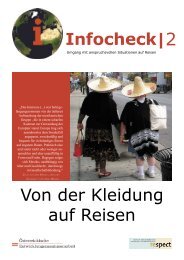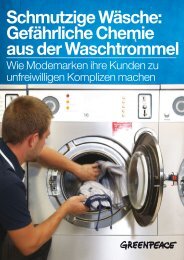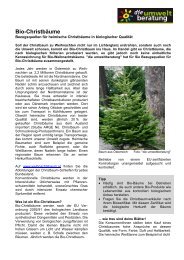Die Schwarze Liste der Pestizide - Greenpeace
Die Schwarze Liste der Pestizide - Greenpeace
Die Schwarze Liste der Pestizide - Greenpeace
Sie wollen auch ein ePaper? Erhöhen Sie die Reichweite Ihrer Titel.
YUMPU macht aus Druck-PDFs automatisch weboptimierte ePaper, die Google liebt.
<strong>Greenpeace</strong> e.V. – <strong>Die</strong> <strong>Schwarze</strong> <strong>Liste</strong> <strong>der</strong> <strong>Pestizide</strong><br />
classification will determine how the Agency regulates the pesticide and will include methods for quantification of human<br />
risk. In some cases, EPA also requests review by the FIFRA Scientific Advisory Panel. For some chemicals, other<br />
groups of EPA scientists have provided the assessment, and OPP uses these assessments.<br />
2. What factors does EPA consi<strong>der</strong> in its review of cancer risk?<br />
When assessing possible cancer risk posed by a pesticide, EPA consi<strong>der</strong>s how strongly carcinogenic the chemical is (its<br />
potency) and the potential for human exposure. The pesticides are evaluated not only to determine if they cause cancer<br />
in laboratory animals, but also as to their potential to cause human cancer. For any pesticide classified as a potential<br />
carcinogen, the risk would depend on the extent to which a person might be exposed (how much time and to what<br />
quantity of the pesticide). The factors consi<strong>der</strong>ed include short-term studies, long-term cancer studies, mutagenicity<br />
studies, and structure activity concerns. (The term “weight-of-the-evidence” is used in referring to such a review. This<br />
means that the recommendation is not based on the results of one study, but on the results of all studies that are<br />
available.)<br />
3. When does EPA review pesticides for potential carcinogenicity?<br />
EPA reviews studies submitted when a pesticide is proposed for registration. Studies are required in two species (mice<br />
and rats) and two sexes (males and females). These studies are required for all pesticides used on food and some non-<br />
food pesticides that could lead to long-term exposures in humans. These studies may be reviewed again when a<br />
pesticide un<strong>der</strong>goes reregistration and the cancer classification may be re-evaluated, particularly if new studies have<br />
been submitted.<br />
4. Why are there several different cancer classifications in the list?<br />
EPA’s guidelines for evaluating the potential carcinogenicity of chemicals have been updated over the years to reflect<br />
increased un<strong>der</strong>standing of ways chemicals may cause cancer. The current guidelines call for greater emphasis on<br />
characterization discussions for hazard, dose-response assessment, exposure assessment, and risk characterization, as<br />
well as the use of mode of action in the assessment of potential carcinogenesis. EPA does not have the resources to re-<br />
evaluate every chemical to determine how it would be described un<strong>der</strong> new guidelines, and there is no reason to re-<br />
evaluate chemicals unless there is some new information that could change the basic un<strong>der</strong>standing of that chemical.<br />
5. How have the guidelines changed?<br />
EPA issued its first set of principles to guide evaluation of human cancer potential in1976. In 1986, EPA issued updated<br />
guidance, which included a letter system (A-E) for designating degree of carcinogenic potential. In the 1986 guidelines,<br />
hazard identification and the weight-of-evidence process focused on tumor findings. The human carcinogenic potential<br />
of agents was characterized by a six-category alphanumeric classification system (A, B1, B2, C, D, and E).<br />
In 1996, EPA released “Proposed Guidelines for Carcinogen Risk Assessment,” which used descriptive phrases rather<br />
than the alphanumeric classification to classify carcinogenic potential. In the 1996 classification structure, increased<br />
emphasis was placed on discussing characterization of hazard, dose-response, and exposure assessments. The hazard<br />
and weight of evidence process embraced an analysis of all relevant biological information and emphasized<br />
un<strong>der</strong>standing the agent's mode of action in producing tumors to reduce the uncertainty in describing the likelihood of<br />
harm.<br />
By 1999, the science related to carcinogens had advanced significantly. EPA issued draft guidelines that continued the<br />
greater emphasis on characterization discussions for hazard, dose-response assessment, exposure assessment, risk<br />
Seite 147 von 166


